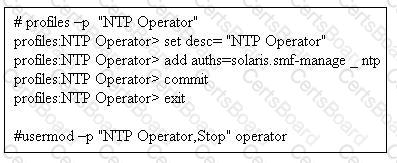Explanation: *vnic-link
A virtual network interface created on a link or an etherstub. It is a pseudo device that can be treated as if it were an network interface card on a machine.
*vlan-link
A VLAN datalink.
*bridge
A bridge instance, identified by an administratively-chosen name. The name may use any alphanumeric characters or the underscore, _, but must start and end with an alphabetic character. A bridge name can be at most 31 characters. The name default is reserved, as are all names starting with SUNW.
Note:
*dladm– administer data links
*The dladm command is used to administer data-links. A data-link is represented in the system as a STREAMS DLPI (v2) interface which can be plumbed under protocol stacks such as TCP/IP. Each data-link relies on either a single network device or an aggregation of devices to send packets to or receive packets from a network.
Each dladm subcommand operates on one of the following objects:
link
A datalink, identified by a name. In general, the name can use any alphanumeric characters (or the underscore, _), but must start with an alphabetic character and end with a number. A datalink name can be at most 31 characters, and the ending number must be between 0 and 4294967294 (inclusive). The ending number must not begin with a zero. Datalink names between 3 and 8 characters are recommended.
Some subcommands operate only on certain types or classes of datalinks. For those cases, the following object names are used:
phys-link
A physical datalink.
vlan-link
A VLAN datalink.
aggr-link
An aggregation datalink (or a key; see NOTES).
ether-link
A physical Ethernet datalink.
wifi-link
A WiFi datalink.
vnic-link
A virtual network interface created on a link or an etherstub. It is a pseudo device that can be treated as if it were an network interface card on a machine.
iptun-link
An IP tunnel link.
dev
A network device, identified by concatenation of a driver name and an instance number.
etherstub
An Ethernet stub can be used instead of a physical NIC to create VNICs. VNICs created on an etherstub will appear to be connected through a virtual switch, allowing complete virtual networks to be built without physical hardware.
bridge
A bridge instance, identified by an administratively-chosen name. The name may use any alphanumeric characters or the underscore, _, but must start and end with an alphabetic character. A bridge name can be at most 31 characters. The name default is reserved, as are all names starting with SUNW.
Note that appending a zero (0) to a bridge name produces a valid link name, used for observability.
secobj
A secure object, identified by an administratively-chosen name. The name can use any alphanumeric characters, as well as underscore (_), period (.), and hyphen (-). A secure object name can be at most 32 characters.




